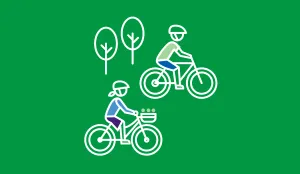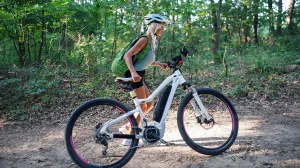
Jose Ponce-Rios, MD, medical director of Pediatric Emergency Services at Lowell General Hospital, has seen it all—from painful road rash and broken bones to traumatic brain injuries.
Here’s what you and your family need to know, whether you’re cruising around the neighborhood or commuting on an e-bike.
- Wear a helmet—every time: It’s simple, helmets save lives. According to the CDC, helmets reduce the risk of head injury by nearly 50%. Model good behavior for kids and make sure everyone’s helmet fits snugly and sits level on their head. Buckle it up every single ride—no exceptions.
- Be visible: Most bike accidents involving cars happen because drivers don’t see cyclists in time. Here's how to stand out:
• Wear bright or reflective clothing, especially at night or in low-light conditions.
• Use front and rear lights. A white light in front helps you see where you’re going and a red light in back lets others see you.
• Add reflectors on your pedals, tires and backpack to increase visibility. - Follow the rules of the road: In Massachusetts you can ride your bicycle on all public roads, streets or bikeways, except where signs specifically prohibit bikes. While laws vary state to state, always remember to:
• Ride in the same direction as traffic.
• Obey traffic signals and signs.
• Use hand signals to indicate turns and stops.
• Yield to pedestrians and be extra cautious at crosswalks.
For more about Massachusetts bike laws, visit MassBike. - Stay aware of your surroundings: Don’t wear headphones or text while riding your bike. Keep your eyes and ears open for vehicles, pedestrians and road hazards. Scan ahead and behind regularly and make eye contact with drivers when possible—don’t assume they see you.
- Check your bike before you ride: A quick safety check before you hop on can prevent accidents and breakdowns:
• Air: Make sure tires are properly inflated.
• Brakes: Squeeze both brake levers to ensure they engage.
• Chain and crank: Look for rust, wear, or anything loose.
• Lights and reflectors: Test your lights and clean your reflectors. - Ride predictably and defensively: Don't weave in and out of traffic. Stay in a straight line and be clear about your movements. Assume cars don’t see you and be ready to react to unexpected doors opening, lane changes or turns.
- Be prepared: Carry essentials like:
• A basic repair kit (patch kit, tire levers, mini pump)
• Water bottle
• ID and phone
• Emergency contact info
Technology and time has given us many tools for trauma care, yet the most important tool we have is prevention.
Jose Ponce-Rios, MD, Medical Director, Pediatric Emergency Services at Lowell General Hospital
The bottom line
Bike riding is fun and healthy when you’re prepared and make good decisions. Teach your kids to ride safely and model safe cycling.
Join Lowell General Hospital and the Bike Safety Rodeo at Bowlero in Lowell on Saturday, May 3, 2025, from 10 am-1 pm to learn about bike safety.


